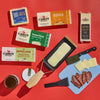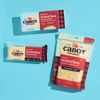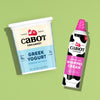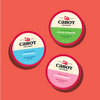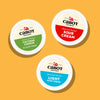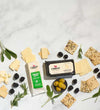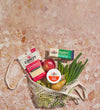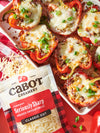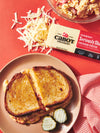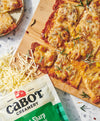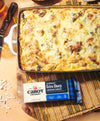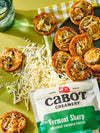Are you eager to make a deliciously creamy cheese sauce for your mac and cheese or add some gooey melted cheese to pour over a veggie dish? Well, the secret to success lies in knowing the right way to melt cheese for a perfectly textured result. It may seem like a simple task, but there are several factors that can make or break your melted cheese. So, whether you prefer mild or sharp cheddar cheese, understanding the factors that can impact the melting process is key. Don't worry, though - we've got you covered with this comprehensive how-to guide that will walk you through everything you need to know to melt cheddar cheese like a true pro!
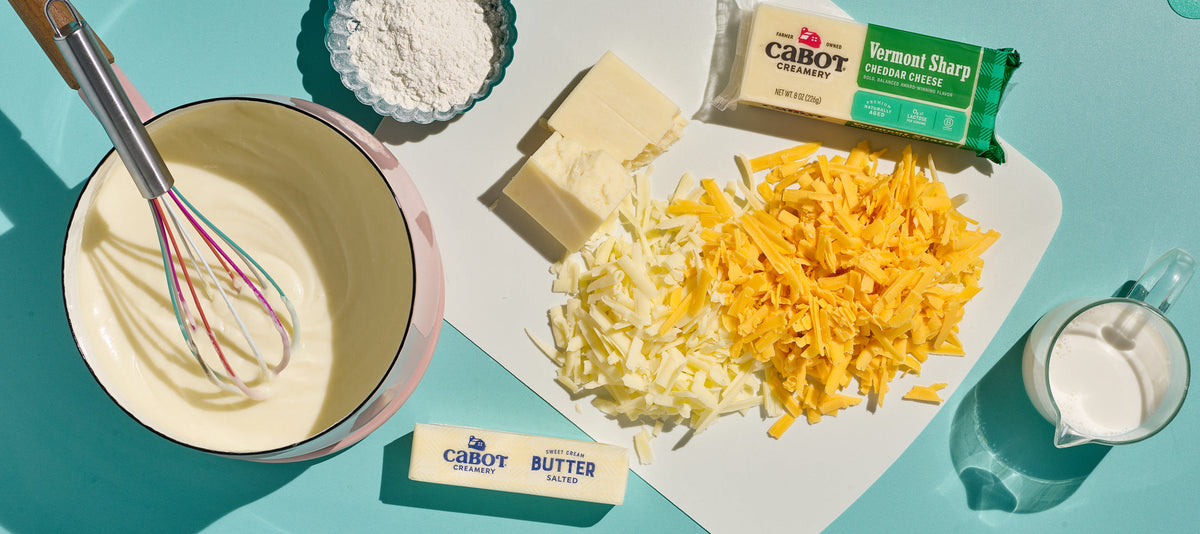
How to Melt Cheese
When it comes to making the perfect cheddar cheese sauce, our recommended method for melting cheddar cheese is the tried-and-true stovetop approach. While it's possible to melt cheese in the microwave, this method is less reliable and you run the risk of overheating or burning the cheese, resulting in an unappealing texture for your sauce. By melting cheddar cheese on the stovetop, you have more control over the process and can better avoid these issues. Plus, this method allows you to customize your cheese sauce to your liking, whether you prefer a thin, pourable consistency or a thicker, creamier texture.
Get our favorite Cheese Sauce recipe now »
 Best Melting Cheese
Best Melting Cheese
To make a delicious cheese sauce every time, you’ll need to know which types of cheeses are best for melting. Since low-fat and low-moisture cheeses (think Romano and Parmesan) burn easily, these are not your ideal melting cheeses. Yes, they will melt into strands that are suitable to sit on top of pasta, but they will not turn into a beautiful, smooth, creamy melted cheese sauce. These types of cheese are best suited for grating over dishes.
Cheeses with more moisture and lower melting points make for mouthwatering, creamy cheese sauces. Cheddar is one of the most popular choices, but Swiss and Gruyère are also terrific options.
1. Start with a Mild or Sharp Cheddar
You’ll find the classic, Cabot cheddar cheese in four basic flavors: Mild, Sharp, Extra Sharp and Seriously Sharp. The sharpness level indicates how long the cheese has been aged, with aging increasing as you go from Mild to Seriously Sharp.The texture of the cheese also changes as the cheese ages. Mild and Sharp Cheddar have a smoother, creamier texture than Extra Sharp and Seriously Sharp Cheddar. They also have a higher moisture content than Extra Sharp and Seriously Sharp Cheddar and are, therefore, easier to melt.
2. Shred the cheese
Wondering how to melt a block of cheese? Shred it first!
The thin and uniform shape of shredded cheese will melt more quickly, easily and evenly than a whole block of cheese, so it’s important to take the time to shred your cheese before starting to melt it. Or pick up our pre-shredded cheeses as an option. This upfront effort will make a huge difference in the outcome of your melted cheese.
💡Let the cheese come to room temperature. If you melt cheese cold, it may cause it to melt slowly or unevenly. Let your cheese sit out until it comes to room temperature before you try to melt it. Most cheese will come to room temperature in about 20 to 30 minutes.
3. Start with a roux and make a bechamel sauce
We recommend starting with a classic roux if making a sauce, like our Cheddar Cheese Sauce – a roux is a mixture of flour & fats used to thicken sauces and enhance flavor and texture. Using a non-stick sauce pan or skillet, such as ceramic or porcelain-enameled, will be a lifesaver. This type of pan will keep stray, sticky strands of cheese from sticking to the sides and make it less likely for your cheese to burn. Not to mention, they’re a breeze to clean!
- Melt 8 tablespoons of butter in a large, heavy, non-stick saucepan over medium heat.
- Whisk in ½ cup of unbleached, all-purpose flour, a little at a time until well blended.
- Whisk in 4 cups of hot milk and continue stirring until melted.
💡Once the hot milk is added, your roux becomes a bechamel sauce!
4. Add cheese and melt until blended
Add the shredded cheese to your sauce and turn the heat on the stove to the lowest setting – you want to melt low and slow!
The rule of thumb when it comes to melting cheese for a sauce is to always melt it at the lowest heat possible because, if you use high heat to melt cheese, you risk losing the moisture and fat in the cheese. This results in melted cheese that is lumpy, greasy, stiff, or charred – qualities you never want a cheese sauce to have!
5. Watch closely & stir often
Melting cheese is not one of those set it and forget it cooking tasks. Whatever you do, don’t leave the cheese unattended on your stove. If you do, it will likely burn and be ruined. Stir the cheese frequently to keep it moving around the pot. This step will ensure the cheese is evenly melted through and prevent it from sticking to the pot and/or burning.
Watch the cheese sauce closely as it melts. Once it looks and feels smooth and has been evenly melted, give it a final stir, and then remove the pan from the heat. If you melt the cheese any longer than is necessary, it can result in a rubbery consistency and negatively impact the flavor.
Cheese Sauce for Nachos, Dips and Veggies
Cheese sauces are phenomenal for a variety of purposes, including pouring over nachos, using as a dip for crackers and fresh veggies and as a topping on pasta or chicken. And of course the all-time favorite mac & cheese.
💡One effortless way to make cheese sauce is to melt butter in a skillet over low heat, adding grated cheese a little at a time. You’ll want each batch of cheese to be completely melted into the butter before putting in the next addition. 🍴Our Queso Fundido with Sausage and Caramelized Onions is a delicious recipe that uses the oven for melting cheese into a spicy-sweet dip for bread or crackers.
🍴Our Queso Fundido with Sausage and Caramelized Onions is a delicious recipe that uses the oven for melting cheese into a spicy-sweet dip for bread or crackers.
🍴Also try our Simple Cheddar Cheese Sauce (ideal as a dip for chips or crackers) and watch the accompanying videos for our Roasted Garlic Cheddar Cheese Sauce and our Jalapeño Cheese Sauce. Now that you’re a cheese melting whiz, you’ll want to add some great snack and meal ideas that incorporate melted cheese to your cooking arsenal.
Now that you’re a cheese melting whiz, you’ll want to add some great snack and meal ideas that incorporate melted cheese to your cooking arsenal.
From using melted cheese for a mouthwatering nacho dip, slathering atop tacos and creating a fabulous cheese fondue, to making the best grilled cheese sandwiches and cheese sauces, there are so many creative and delicious ways to use melted cheese.
🍴Some additional favorites are Hot Italian Cheddar Dip and Cabot Sharp Cheddar Fondue.

How to Melt Cheese in a Grilled Cheese or Quesadilla
The key is to make sure you use a cheese that melts well. Ones to avoid are Parmesan and Pecorino (any hard, aged cheeses), goat and feta (any dry, crumbly cheeses) as they don’t melt well.
Cheeses that are made for melting in grilled cheese and quesadillas include Cheddar, American, Swiss and Cabot’s creamy Monterey Jack.
🍴For an excellent spin on the traditional grilled cheese sandwich, try our Eggs Benedict Grilled Cheese with Hollandaise Sauce.
🍴For next-level quesadillas, try our Roast Beef and Cheese Quesadillas and our Shrimp & Habanero Quesadillas. For a meatless option, try our Roasted Butternut Squash Quesadillas with Cheddar.
How to Melt Cheese on Top of Nachos and Other Food
When making nachos and casseroles sprinkle the shredded cheese on top of your dish and then place it in the oven according to the recipe instructions. The general rule is to bake the dish until the cheese is bubbly and melted, which will vary based on the oven temperature and type of cheese being used. Remember to check the cheese at the lower end of the cooking time noted in the recipe to avoid burning the cheese. If the dish needs to bake longer, keep a close eye on it and check often. Some recipes call for the cheese-topped casserole to be covered with foil for the beginning of the cook time, with the foil removed at the end to complete the melting and browning of the cheese.

How to Melt Just Cheese
If you want to melt just cheese, here's how to melt cheese the slow and steady way: use low heat—introduce a double-boiler, even—to avoid overcooking. If you want to speed up the melting a little more, try grating the cheese instead of cranking the temperature—the thin and uniform shape will melt faster and more evenly.
💡A double boiler allows us to melt cheese using indirect heat (steam) rather than direct heat from a stove or radiation
Bonus tip:
For extra smooth results - and to add a little flavor boost to your cheese - stir in a little wine or beer as it melts. You're welcome!
FAQ:
What is the best way to melt cheese?
Our recommended method for melting cheese is the tried-and-true stovetop approach, or making a Cheddar Cheese Sauce.
How do you melt cheese on the stove?
You can add cheese to a bechamel (white sauce) for a creamy sauce, or melt cheese by itself using the double-boiler method - slow and steady!
How do you melt cheese in the microwave?
Melting cheese in the microwave is less consistent and less reliable, but if you’re in a pinch, start by bringing grated cheese to room temperature first. Cover with a vented lid and melt at LOW heat in 15-second increments, stirring in between.
What is the best melting cheese?
Cheeses with more moisture and lower melting points - cheddar is one of the most popular choices, but Swiss and Gruyère are also terrific options.
Which melts better, mild or sharp cheddar?
Mild cheddar melts more smoothly than sharper (more aged) cheddar.
Why won’t my cheese melt?
There are many reasons, but the biggest is the moisture content. The moisture content of the cheese has a great effect on the melting process. Cheese that contains higher amounts of fat will melt better than one that doesn't.
Why won’t my pre-shredded cheese melt?
Pre-shredded cheese is best for melting on top of things, like nachos and pizza, but if you have the time, freshly grated cheese will melt best in sauces and stovetop dishes.
Pre-shredded cheese contains ingredients like potato starch and natamycin to keep the shreds from clumping together in the bag. That means that sometimes, pre-shredded cheese won’t melt as easily as it would if you grated a cheese block yourself!
For more melty, cheesy goodness, be sure to check out our cheese accessories page and delicious Curated Cheese Bundles, Cabot has got the perfect gift for the melted cheese lover in your life (even if it's you!).
